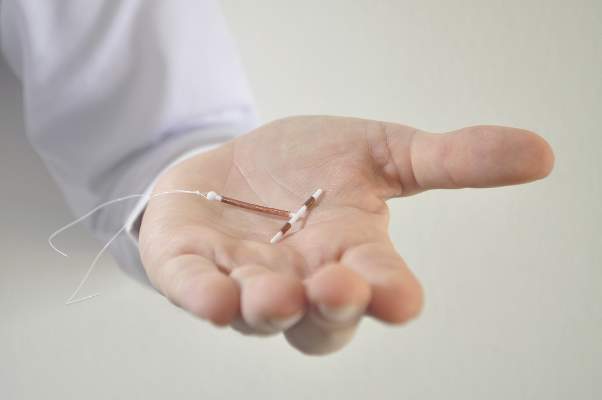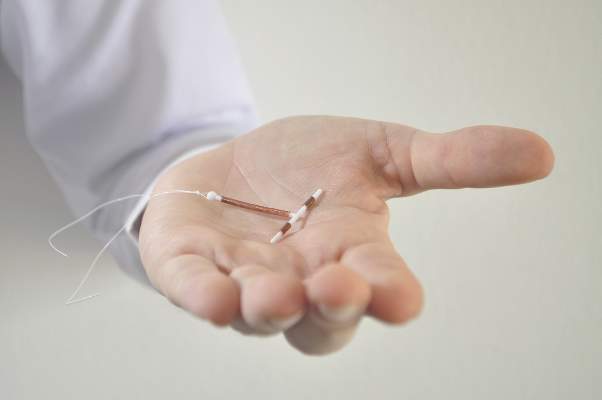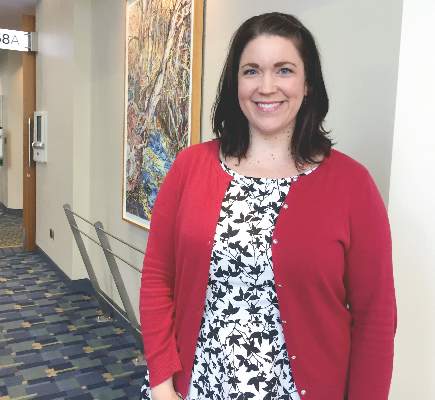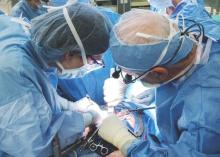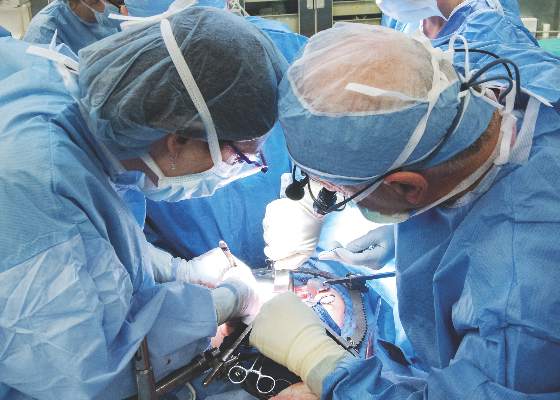User login
Three U.S. infants born with birth defects linked to Zika virus
There have been three infants born with birth defects and three pregnancy losses as a result of likely maternal Zika virus infection among U.S. women, according to figures released by the Centers for Disease Control and Prevention.
The figures, posted by the CDC on June 16, reflect reporting to the U.S. Zika Pregnancy Registry as of June 9. This is not real-time data and reflects only pregnancy outcomes for women with any laboratory evidence of possible Zika virus infection, though it is not known if Zika virus was the cause of the poor outcomes. The numbers also do not reflect outcomes among ongoing pregnancies.
Zika-related birth defects recorded by the CDC could include microcephaly, calcium deposits in the brain indicating possible brain damage, excess fluid in the brain cavities and surrounding the brain, absent or poorly formed brain structures, abnormal eye development, or other problems resulting from brain damage that affect nerves, muscles, and bones. The pregnancy losses encompass any miscarriage, stillbirth, and termination with evidence of birth defects.
The current numbers include outcomes reported in U.S. states and the District of Columbia. The CDC will begin reporting outcomes in U.S. territories in the coming weeks.
CDC officials plan to update the pregnancy outcome data every Thursday at http://www.cdc.gov/zika/geo/pregnancy-outcomes.html.
On Twitter @maryellenny
There have been three infants born with birth defects and three pregnancy losses as a result of likely maternal Zika virus infection among U.S. women, according to figures released by the Centers for Disease Control and Prevention.
The figures, posted by the CDC on June 16, reflect reporting to the U.S. Zika Pregnancy Registry as of June 9. This is not real-time data and reflects only pregnancy outcomes for women with any laboratory evidence of possible Zika virus infection, though it is not known if Zika virus was the cause of the poor outcomes. The numbers also do not reflect outcomes among ongoing pregnancies.
Zika-related birth defects recorded by the CDC could include microcephaly, calcium deposits in the brain indicating possible brain damage, excess fluid in the brain cavities and surrounding the brain, absent or poorly formed brain structures, abnormal eye development, or other problems resulting from brain damage that affect nerves, muscles, and bones. The pregnancy losses encompass any miscarriage, stillbirth, and termination with evidence of birth defects.
The current numbers include outcomes reported in U.S. states and the District of Columbia. The CDC will begin reporting outcomes in U.S. territories in the coming weeks.
CDC officials plan to update the pregnancy outcome data every Thursday at http://www.cdc.gov/zika/geo/pregnancy-outcomes.html.
On Twitter @maryellenny
There have been three infants born with birth defects and three pregnancy losses as a result of likely maternal Zika virus infection among U.S. women, according to figures released by the Centers for Disease Control and Prevention.
The figures, posted by the CDC on June 16, reflect reporting to the U.S. Zika Pregnancy Registry as of June 9. This is not real-time data and reflects only pregnancy outcomes for women with any laboratory evidence of possible Zika virus infection, though it is not known if Zika virus was the cause of the poor outcomes. The numbers also do not reflect outcomes among ongoing pregnancies.
Zika-related birth defects recorded by the CDC could include microcephaly, calcium deposits in the brain indicating possible brain damage, excess fluid in the brain cavities and surrounding the brain, absent or poorly formed brain structures, abnormal eye development, or other problems resulting from brain damage that affect nerves, muscles, and bones. The pregnancy losses encompass any miscarriage, stillbirth, and termination with evidence of birth defects.
The current numbers include outcomes reported in U.S. states and the District of Columbia. The CDC will begin reporting outcomes in U.S. territories in the coming weeks.
CDC officials plan to update the pregnancy outcome data every Thursday at http://www.cdc.gov/zika/geo/pregnancy-outcomes.html.
On Twitter @maryellenny
Immediate Postpartum IUD Insertion Causes Little Pain, Distress
WASHINGTON – Many women who underwent post-placental IUD insertion reported little or no pain, regardless of whether they had an epidural during childbirth, according to the findings of a small pilot study.
Dr. Shannon Carr and her colleagues at the University of New Mexico, Albuquerque, assessed 66 women using both a 100-mm visual analog pain scale (VAS) and a four-point Likert verbal rating scale (VRS). They also interviewed a subset of the participants to gather qualitative data about the experience. About half the group received an epidural (36 women) and half did not (30 women).
The VAS scores did not reveal normal distributions and the standard deviations were large, which was not statistically meaningful, according to Dr. Carr. The median scores were 40.5 mm and 2.8 mm in the no-epidural and epidural groups, respectively. But using the four-point pain scale – none, mild, moderate, and severe – the researchers found that 53% of women in the no-epidural group reported pain ranging from none to mild, while 89% of women in the epidural group reported pain in the none-to-mild range.
“What I saw basically reflected what we call the floor effect of the VAS scores in the epidural group. Most of the women hardly had any pain,” Dr. Carr said at the annual meeting of the American College of Obstetricians and Gynecologists. “Women who did not have an epidural reported scores that were all over the map.”
The results help to shed light on what is probably the most common question asked by women considering post-placental IUD insertion – Will it hurt?
“The more we learn about it, the more we can reassure women and counsel them appropriately about what to expect, not only clinically but on a personal level with their labor experience,” Dr. Carr said. “I think that’s really important, and it might promote uptake of the procedure and more women getting really effective contraception before leaving the hospital.”
Qualitative data, based on interviews with 9 women in the no-epidural group and 12 in the epidural group, showed that they had no regrets about the procedure, and most reported that it didn’t detract from their overall labor experience. Instead, most of the women in the study said that holding their newborn baby was a pleasant distraction from the placement of the IUD.
The primary driver for undergoing IUD insertion immediately post partum was convenience. “They wanted to have really good birth control on board before they left the hospital,” Dr. Carr said. “They recognize those logistical barriers to getting to that 6-week postpartum visit.”
The researchers did not report having any financial disclosures.
WASHINGTON – Many women who underwent post-placental IUD insertion reported little or no pain, regardless of whether they had an epidural during childbirth, according to the findings of a small pilot study.
Dr. Shannon Carr and her colleagues at the University of New Mexico, Albuquerque, assessed 66 women using both a 100-mm visual analog pain scale (VAS) and a four-point Likert verbal rating scale (VRS). They also interviewed a subset of the participants to gather qualitative data about the experience. About half the group received an epidural (36 women) and half did not (30 women).
The VAS scores did not reveal normal distributions and the standard deviations were large, which was not statistically meaningful, according to Dr. Carr. The median scores were 40.5 mm and 2.8 mm in the no-epidural and epidural groups, respectively. But using the four-point pain scale – none, mild, moderate, and severe – the researchers found that 53% of women in the no-epidural group reported pain ranging from none to mild, while 89% of women in the epidural group reported pain in the none-to-mild range.
“What I saw basically reflected what we call the floor effect of the VAS scores in the epidural group. Most of the women hardly had any pain,” Dr. Carr said at the annual meeting of the American College of Obstetricians and Gynecologists. “Women who did not have an epidural reported scores that were all over the map.”
The results help to shed light on what is probably the most common question asked by women considering post-placental IUD insertion – Will it hurt?
“The more we learn about it, the more we can reassure women and counsel them appropriately about what to expect, not only clinically but on a personal level with their labor experience,” Dr. Carr said. “I think that’s really important, and it might promote uptake of the procedure and more women getting really effective contraception before leaving the hospital.”
Qualitative data, based on interviews with 9 women in the no-epidural group and 12 in the epidural group, showed that they had no regrets about the procedure, and most reported that it didn’t detract from their overall labor experience. Instead, most of the women in the study said that holding their newborn baby was a pleasant distraction from the placement of the IUD.
The primary driver for undergoing IUD insertion immediately post partum was convenience. “They wanted to have really good birth control on board before they left the hospital,” Dr. Carr said. “They recognize those logistical barriers to getting to that 6-week postpartum visit.”
The researchers did not report having any financial disclosures.
WASHINGTON – Many women who underwent post-placental IUD insertion reported little or no pain, regardless of whether they had an epidural during childbirth, according to the findings of a small pilot study.
Dr. Shannon Carr and her colleagues at the University of New Mexico, Albuquerque, assessed 66 women using both a 100-mm visual analog pain scale (VAS) and a four-point Likert verbal rating scale (VRS). They also interviewed a subset of the participants to gather qualitative data about the experience. About half the group received an epidural (36 women) and half did not (30 women).
The VAS scores did not reveal normal distributions and the standard deviations were large, which was not statistically meaningful, according to Dr. Carr. The median scores were 40.5 mm and 2.8 mm in the no-epidural and epidural groups, respectively. But using the four-point pain scale – none, mild, moderate, and severe – the researchers found that 53% of women in the no-epidural group reported pain ranging from none to mild, while 89% of women in the epidural group reported pain in the none-to-mild range.
“What I saw basically reflected what we call the floor effect of the VAS scores in the epidural group. Most of the women hardly had any pain,” Dr. Carr said at the annual meeting of the American College of Obstetricians and Gynecologists. “Women who did not have an epidural reported scores that were all over the map.”
The results help to shed light on what is probably the most common question asked by women considering post-placental IUD insertion – Will it hurt?
“The more we learn about it, the more we can reassure women and counsel them appropriately about what to expect, not only clinically but on a personal level with their labor experience,” Dr. Carr said. “I think that’s really important, and it might promote uptake of the procedure and more women getting really effective contraception before leaving the hospital.”
Qualitative data, based on interviews with 9 women in the no-epidural group and 12 in the epidural group, showed that they had no regrets about the procedure, and most reported that it didn’t detract from their overall labor experience. Instead, most of the women in the study said that holding their newborn baby was a pleasant distraction from the placement of the IUD.
The primary driver for undergoing IUD insertion immediately post partum was convenience. “They wanted to have really good birth control on board before they left the hospital,” Dr. Carr said. “They recognize those logistical barriers to getting to that 6-week postpartum visit.”
The researchers did not report having any financial disclosures.
AT ACOG 2016
Immediate postpartum IUD insertion causes little pain, distress
WASHINGTON – Many women who underwent post-placental IUD insertion reported little or no pain, regardless of whether they had an epidural during childbirth, according to the findings of a small pilot study.
Dr. Shannon Carr and her colleagues at the University of New Mexico, Albuquerque, assessed 66 women using both a 100-mm visual analog pain scale (VAS) and a four-point Likert verbal rating scale (VRS). They also interviewed a subset of the participants to gather qualitative data about the experience. About half the group received an epidural (36 women) and half did not (30 women).
The VAS scores did not reveal normal distributions and the standard deviations were large, which was not statistically meaningful, according to Dr. Carr. The median scores were 40.5 mm and 2.8 mm in the no-epidural and epidural groups, respectively. But using the four-point pain scale – none, mild, moderate, and severe – the researchers found that 53% of women in the no-epidural group reported pain ranging from none to mild, while 89% of women in the epidural group reported pain in the none-to-mild range.
“What I saw basically reflected what we call the floor effect of the VAS scores in the epidural group. Most of the women hardly had any pain,” Dr. Carr said at the annual meeting of the American College of Obstetricians and Gynecologists. “Women who did not have an epidural reported scores that were all over the map.”
The results help to shed light on what is probably the most common question asked by women considering post-placental IUD insertion – Will it hurt?
“The more we learn about it, the more we can reassure women and counsel them appropriately about what to expect, not only clinically but on a personal level with their labor experience,” Dr. Carr said. “I think that’s really important, and it might promote uptake of the procedure and more women getting really effective contraception before leaving the hospital.”
Qualitative data, based on interviews with 9 women in the no-epidural group and 12 in the epidural group, showed that they had no regrets about the procedure, and most reported that it didn’t detract from their overall labor experience. Instead, most of the women in the study said that holding their newborn baby was a pleasant distraction from the placement of the IUD.
The primary driver for undergoing IUD insertion immediately post partum was convenience. “They wanted to have really good birth control on board before they left the hospital,” Dr. Carr said. “They recognize those logistical barriers to getting to that 6-week postpartum visit.”
The researchers did not report having any financial disclosures.
On Twitter @maryellenny
WASHINGTON – Many women who underwent post-placental IUD insertion reported little or no pain, regardless of whether they had an epidural during childbirth, according to the findings of a small pilot study.
Dr. Shannon Carr and her colleagues at the University of New Mexico, Albuquerque, assessed 66 women using both a 100-mm visual analog pain scale (VAS) and a four-point Likert verbal rating scale (VRS). They also interviewed a subset of the participants to gather qualitative data about the experience. About half the group received an epidural (36 women) and half did not (30 women).
The VAS scores did not reveal normal distributions and the standard deviations were large, which was not statistically meaningful, according to Dr. Carr. The median scores were 40.5 mm and 2.8 mm in the no-epidural and epidural groups, respectively. But using the four-point pain scale – none, mild, moderate, and severe – the researchers found that 53% of women in the no-epidural group reported pain ranging from none to mild, while 89% of women in the epidural group reported pain in the none-to-mild range.
“What I saw basically reflected what we call the floor effect of the VAS scores in the epidural group. Most of the women hardly had any pain,” Dr. Carr said at the annual meeting of the American College of Obstetricians and Gynecologists. “Women who did not have an epidural reported scores that were all over the map.”
The results help to shed light on what is probably the most common question asked by women considering post-placental IUD insertion – Will it hurt?
“The more we learn about it, the more we can reassure women and counsel them appropriately about what to expect, not only clinically but on a personal level with their labor experience,” Dr. Carr said. “I think that’s really important, and it might promote uptake of the procedure and more women getting really effective contraception before leaving the hospital.”
Qualitative data, based on interviews with 9 women in the no-epidural group and 12 in the epidural group, showed that they had no regrets about the procedure, and most reported that it didn’t detract from their overall labor experience. Instead, most of the women in the study said that holding their newborn baby was a pleasant distraction from the placement of the IUD.
The primary driver for undergoing IUD insertion immediately post partum was convenience. “They wanted to have really good birth control on board before they left the hospital,” Dr. Carr said. “They recognize those logistical barriers to getting to that 6-week postpartum visit.”
The researchers did not report having any financial disclosures.
On Twitter @maryellenny
WASHINGTON – Many women who underwent post-placental IUD insertion reported little or no pain, regardless of whether they had an epidural during childbirth, according to the findings of a small pilot study.
Dr. Shannon Carr and her colleagues at the University of New Mexico, Albuquerque, assessed 66 women using both a 100-mm visual analog pain scale (VAS) and a four-point Likert verbal rating scale (VRS). They also interviewed a subset of the participants to gather qualitative data about the experience. About half the group received an epidural (36 women) and half did not (30 women).
The VAS scores did not reveal normal distributions and the standard deviations were large, which was not statistically meaningful, according to Dr. Carr. The median scores were 40.5 mm and 2.8 mm in the no-epidural and epidural groups, respectively. But using the four-point pain scale – none, mild, moderate, and severe – the researchers found that 53% of women in the no-epidural group reported pain ranging from none to mild, while 89% of women in the epidural group reported pain in the none-to-mild range.
“What I saw basically reflected what we call the floor effect of the VAS scores in the epidural group. Most of the women hardly had any pain,” Dr. Carr said at the annual meeting of the American College of Obstetricians and Gynecologists. “Women who did not have an epidural reported scores that were all over the map.”
The results help to shed light on what is probably the most common question asked by women considering post-placental IUD insertion – Will it hurt?
“The more we learn about it, the more we can reassure women and counsel them appropriately about what to expect, not only clinically but on a personal level with their labor experience,” Dr. Carr said. “I think that’s really important, and it might promote uptake of the procedure and more women getting really effective contraception before leaving the hospital.”
Qualitative data, based on interviews with 9 women in the no-epidural group and 12 in the epidural group, showed that they had no regrets about the procedure, and most reported that it didn’t detract from their overall labor experience. Instead, most of the women in the study said that holding their newborn baby was a pleasant distraction from the placement of the IUD.
The primary driver for undergoing IUD insertion immediately post partum was convenience. “They wanted to have really good birth control on board before they left the hospital,” Dr. Carr said. “They recognize those logistical barriers to getting to that 6-week postpartum visit.”
The researchers did not report having any financial disclosures.
On Twitter @maryellenny
AT ACOG 2016
Key clinical point: Many women felt little to no pain during post-placental IUD insertion.
Major finding: More than half of women (53%) who did not have an epidural, and 89% of women who did, reported experiencing little to no pain during post-placental IUD insertion.
Data source: A mixed-methods pilot study of 66 women.
Disclosures: The researchers did not report having any financial disclosures.
The health impact of provider-targeted abortion laws
As the U.S. Supreme Court is poised to decide the fate of a set of abortion regulations in Texas, some ob.gyns. are pointing out the negative public health consequences of restricting access to the procedure.
In the case of Whole Woman’s Health v. Hellerstedt – likely to be decided by the Supreme Court in June – the justices must weigh whether Texas officials are placing an undue burden on a woman’s ability to access abortion by levying regulations on abortion providers and facilities. The court heard oral arguments on the case on March 2.
The regulations, enacted in 2013, require facilities that provide abortions – both surgical and medical – to meet the standards of ambulatory surgical centers. The Texas regulations also require abortion providers to have admitting privileges at a hospital within 30 miles of their clinic.
Texas health officials and abortion opponents call the regulations common sense safety measures to protect women’s health. But the American College of Obstetricians and Gynecologists and other medical groups object to the restrictions on the practice of medicine and refer to them as targeted regulation of abortion provider or TRAP laws.
“They seem very reasonable to the public, I think, and also to legislators,” Dr. Diane Horvath-Cosper, an ob.gyn. and abortion provider in Washington, said at the ACOG annual meeting. But “they’re not medically necessary. In fact, not only are they not medically necessary, they’re harmful in that they result in the closure of numerous clinics. They put a lot of doctors and nurses and good people out of this business and [cause] really restricted access. We’re just now understanding how much that is the case.”
Dr. Horvath-Cosper conducted a scientific and legal analysis of the so-called TRAP laws and concluded that they increase the risks of travel, abortion at later gestational ages, the possibility of being denied abortion entirely, and could possibly lead to the resurgence of illegal abortions.
As of March 2016, 24 states had laws or policies that fit the definition of a TRAP law and applied to all clinics in their state providing surgical abortion, according to the Guttmacher Institute. But Texas, whose far-reaching regulations are being reviewed by the Supreme Court, has become the embodiment of the push to adopt TRAP laws.
In Texas, TRAP laws have contributed to closing about three-quarters of the abortion-providing facilities in the state, Dr. Horvath-Cosper said. Since Texas is so large, this leaves many areas without any access to abortion services.
Those closures have had a trickle-down effect, shutting off access to some family planning services and cancer screening programs that are required to be delivered through certified facilities, many of which were clinics providing abortions. With the closure of those clinics, many women – typically minority and low-income women – are now having difficulty accessing basic health care services, Dr. Horvath-Cosper said.
“This is already a marginalized group of women who already have disparate health outcomes,” she said.
The closure of these clinics is also prompting women to drive greater distances for abortion services, frequently into neighboring states, Dr. Horvath-Cosper said. “They may be actually eclipsing the risk of the procedure with the mileage on their car,” she said. “So if you drive 758 highway miles, you hit the risk of mortality for legal, induced abortion.”
Dr. Neha Bhardwaj, an ob.gyn. at the University of New Mexico, Albuquerque, said she has seen many Texas women who come to Albuquerque seeking an abortion.
“I am not originally from New Mexico, so when I moved there 2 years ago what I started seeing was an increase in patients that weren’t from New Mexico, that were from Texas and other surrounding states,” she said at the ACOG annual meeting.
The observation prompted her to look at the data. She compared clinic visits at the University of New Mexico, Albuquerque, from 2011 to 2012 and from 2014 to 2015; Texas women seeking abortion services increased 400% between the two time periods.
Later this year, she hopes to complete a larger study looking at additional abortion clinics in New Mexico to quantify the increase in women traveling from Texas to obtain abortions.
Another health concern resulting from lack of legal abortion access is women seeking to self-abort.
“People are going to Mexico to buy drugs – which may or may not be real drugs – or they are using things in their home,” Dr. Horvath-Cosper said. “We’re getting calls at clinics across the country that women are saying, ‘I have these things in my kitchen cabinet, what can I do to have an abortion.’”
She referenced statistics from the Texas Policy Evaluation Project, which estimates that at least 100,000 Texas women aged 18-49 years have ever attempted to self-induce an abortion.
But not all ob.gyns. are opposed to TRAP laws. Dr. Julie Mickelson, an ob.gyn. in Milwaukee, said that the Texas regulations are designed to protect women from receiving “substandard care” and that they are a reasonable way to ensure a sterile, safe environment with qualified providers.
“It’s a surgical procedure, and there are risks. I’ve taken care of a number of patients over the years – I’ve been practicing for 20 years – who just show up in the emergency department after having had their abortions, with horrible complications,” Dr. Mickelson, who serves on the board of the American Association of Pro-Life Obstetricians and Gynecologists (AAPLOG), said in an interview.
AAPLOG submitted an amicus brief supporting the Texas position in Whole Woman’s Health v. Hellerstedt. The organization cited state inspections of abortion facilities that had found poor training, unsterile conditions, lack of medical personnel, expired credentials, and providers performing abortion beyond the legal gestational limit.
Dr. Donna Harrison, AAPLOG executive director, echoed that position, saying in an interview that the state has an obligation to regulate medicine within its borders.
“Those who promote and profit from abortion, in general, want to say simultaneously that abortion is just like every other medical procedure, and at the same time say abortion is different from every other medical procedure,” she said. As for public health implications, she said elective abortion is an elective medical procedure and reducing it will only improve public health by decreasing preterm birth rates over the long term.
“It’s incoherent to say that decreasing an elective medical procedure is some kind of a public health risk,” she said. “In fact, it’s just exactly the opposite.”
On Twitter @maryellenny
As the U.S. Supreme Court is poised to decide the fate of a set of abortion regulations in Texas, some ob.gyns. are pointing out the negative public health consequences of restricting access to the procedure.
In the case of Whole Woman’s Health v. Hellerstedt – likely to be decided by the Supreme Court in June – the justices must weigh whether Texas officials are placing an undue burden on a woman’s ability to access abortion by levying regulations on abortion providers and facilities. The court heard oral arguments on the case on March 2.
The regulations, enacted in 2013, require facilities that provide abortions – both surgical and medical – to meet the standards of ambulatory surgical centers. The Texas regulations also require abortion providers to have admitting privileges at a hospital within 30 miles of their clinic.
Texas health officials and abortion opponents call the regulations common sense safety measures to protect women’s health. But the American College of Obstetricians and Gynecologists and other medical groups object to the restrictions on the practice of medicine and refer to them as targeted regulation of abortion provider or TRAP laws.
“They seem very reasonable to the public, I think, and also to legislators,” Dr. Diane Horvath-Cosper, an ob.gyn. and abortion provider in Washington, said at the ACOG annual meeting. But “they’re not medically necessary. In fact, not only are they not medically necessary, they’re harmful in that they result in the closure of numerous clinics. They put a lot of doctors and nurses and good people out of this business and [cause] really restricted access. We’re just now understanding how much that is the case.”
Dr. Horvath-Cosper conducted a scientific and legal analysis of the so-called TRAP laws and concluded that they increase the risks of travel, abortion at later gestational ages, the possibility of being denied abortion entirely, and could possibly lead to the resurgence of illegal abortions.
As of March 2016, 24 states had laws or policies that fit the definition of a TRAP law and applied to all clinics in their state providing surgical abortion, according to the Guttmacher Institute. But Texas, whose far-reaching regulations are being reviewed by the Supreme Court, has become the embodiment of the push to adopt TRAP laws.
In Texas, TRAP laws have contributed to closing about three-quarters of the abortion-providing facilities in the state, Dr. Horvath-Cosper said. Since Texas is so large, this leaves many areas without any access to abortion services.
Those closures have had a trickle-down effect, shutting off access to some family planning services and cancer screening programs that are required to be delivered through certified facilities, many of which were clinics providing abortions. With the closure of those clinics, many women – typically minority and low-income women – are now having difficulty accessing basic health care services, Dr. Horvath-Cosper said.
“This is already a marginalized group of women who already have disparate health outcomes,” she said.
The closure of these clinics is also prompting women to drive greater distances for abortion services, frequently into neighboring states, Dr. Horvath-Cosper said. “They may be actually eclipsing the risk of the procedure with the mileage on their car,” she said. “So if you drive 758 highway miles, you hit the risk of mortality for legal, induced abortion.”
Dr. Neha Bhardwaj, an ob.gyn. at the University of New Mexico, Albuquerque, said she has seen many Texas women who come to Albuquerque seeking an abortion.
“I am not originally from New Mexico, so when I moved there 2 years ago what I started seeing was an increase in patients that weren’t from New Mexico, that were from Texas and other surrounding states,” she said at the ACOG annual meeting.
The observation prompted her to look at the data. She compared clinic visits at the University of New Mexico, Albuquerque, from 2011 to 2012 and from 2014 to 2015; Texas women seeking abortion services increased 400% between the two time periods.
Later this year, she hopes to complete a larger study looking at additional abortion clinics in New Mexico to quantify the increase in women traveling from Texas to obtain abortions.
Another health concern resulting from lack of legal abortion access is women seeking to self-abort.
“People are going to Mexico to buy drugs – which may or may not be real drugs – or they are using things in their home,” Dr. Horvath-Cosper said. “We’re getting calls at clinics across the country that women are saying, ‘I have these things in my kitchen cabinet, what can I do to have an abortion.’”
She referenced statistics from the Texas Policy Evaluation Project, which estimates that at least 100,000 Texas women aged 18-49 years have ever attempted to self-induce an abortion.
But not all ob.gyns. are opposed to TRAP laws. Dr. Julie Mickelson, an ob.gyn. in Milwaukee, said that the Texas regulations are designed to protect women from receiving “substandard care” and that they are a reasonable way to ensure a sterile, safe environment with qualified providers.
“It’s a surgical procedure, and there are risks. I’ve taken care of a number of patients over the years – I’ve been practicing for 20 years – who just show up in the emergency department after having had their abortions, with horrible complications,” Dr. Mickelson, who serves on the board of the American Association of Pro-Life Obstetricians and Gynecologists (AAPLOG), said in an interview.
AAPLOG submitted an amicus brief supporting the Texas position in Whole Woman’s Health v. Hellerstedt. The organization cited state inspections of abortion facilities that had found poor training, unsterile conditions, lack of medical personnel, expired credentials, and providers performing abortion beyond the legal gestational limit.
Dr. Donna Harrison, AAPLOG executive director, echoed that position, saying in an interview that the state has an obligation to regulate medicine within its borders.
“Those who promote and profit from abortion, in general, want to say simultaneously that abortion is just like every other medical procedure, and at the same time say abortion is different from every other medical procedure,” she said. As for public health implications, she said elective abortion is an elective medical procedure and reducing it will only improve public health by decreasing preterm birth rates over the long term.
“It’s incoherent to say that decreasing an elective medical procedure is some kind of a public health risk,” she said. “In fact, it’s just exactly the opposite.”
On Twitter @maryellenny
As the U.S. Supreme Court is poised to decide the fate of a set of abortion regulations in Texas, some ob.gyns. are pointing out the negative public health consequences of restricting access to the procedure.
In the case of Whole Woman’s Health v. Hellerstedt – likely to be decided by the Supreme Court in June – the justices must weigh whether Texas officials are placing an undue burden on a woman’s ability to access abortion by levying regulations on abortion providers and facilities. The court heard oral arguments on the case on March 2.
The regulations, enacted in 2013, require facilities that provide abortions – both surgical and medical – to meet the standards of ambulatory surgical centers. The Texas regulations also require abortion providers to have admitting privileges at a hospital within 30 miles of their clinic.
Texas health officials and abortion opponents call the regulations common sense safety measures to protect women’s health. But the American College of Obstetricians and Gynecologists and other medical groups object to the restrictions on the practice of medicine and refer to them as targeted regulation of abortion provider or TRAP laws.
“They seem very reasonable to the public, I think, and also to legislators,” Dr. Diane Horvath-Cosper, an ob.gyn. and abortion provider in Washington, said at the ACOG annual meeting. But “they’re not medically necessary. In fact, not only are they not medically necessary, they’re harmful in that they result in the closure of numerous clinics. They put a lot of doctors and nurses and good people out of this business and [cause] really restricted access. We’re just now understanding how much that is the case.”
Dr. Horvath-Cosper conducted a scientific and legal analysis of the so-called TRAP laws and concluded that they increase the risks of travel, abortion at later gestational ages, the possibility of being denied abortion entirely, and could possibly lead to the resurgence of illegal abortions.
As of March 2016, 24 states had laws or policies that fit the definition of a TRAP law and applied to all clinics in their state providing surgical abortion, according to the Guttmacher Institute. But Texas, whose far-reaching regulations are being reviewed by the Supreme Court, has become the embodiment of the push to adopt TRAP laws.
In Texas, TRAP laws have contributed to closing about three-quarters of the abortion-providing facilities in the state, Dr. Horvath-Cosper said. Since Texas is so large, this leaves many areas without any access to abortion services.
Those closures have had a trickle-down effect, shutting off access to some family planning services and cancer screening programs that are required to be delivered through certified facilities, many of which were clinics providing abortions. With the closure of those clinics, many women – typically minority and low-income women – are now having difficulty accessing basic health care services, Dr. Horvath-Cosper said.
“This is already a marginalized group of women who already have disparate health outcomes,” she said.
The closure of these clinics is also prompting women to drive greater distances for abortion services, frequently into neighboring states, Dr. Horvath-Cosper said. “They may be actually eclipsing the risk of the procedure with the mileage on their car,” she said. “So if you drive 758 highway miles, you hit the risk of mortality for legal, induced abortion.”
Dr. Neha Bhardwaj, an ob.gyn. at the University of New Mexico, Albuquerque, said she has seen many Texas women who come to Albuquerque seeking an abortion.
“I am not originally from New Mexico, so when I moved there 2 years ago what I started seeing was an increase in patients that weren’t from New Mexico, that were from Texas and other surrounding states,” she said at the ACOG annual meeting.
The observation prompted her to look at the data. She compared clinic visits at the University of New Mexico, Albuquerque, from 2011 to 2012 and from 2014 to 2015; Texas women seeking abortion services increased 400% between the two time periods.
Later this year, she hopes to complete a larger study looking at additional abortion clinics in New Mexico to quantify the increase in women traveling from Texas to obtain abortions.
Another health concern resulting from lack of legal abortion access is women seeking to self-abort.
“People are going to Mexico to buy drugs – which may or may not be real drugs – or they are using things in their home,” Dr. Horvath-Cosper said. “We’re getting calls at clinics across the country that women are saying, ‘I have these things in my kitchen cabinet, what can I do to have an abortion.’”
She referenced statistics from the Texas Policy Evaluation Project, which estimates that at least 100,000 Texas women aged 18-49 years have ever attempted to self-induce an abortion.
But not all ob.gyns. are opposed to TRAP laws. Dr. Julie Mickelson, an ob.gyn. in Milwaukee, said that the Texas regulations are designed to protect women from receiving “substandard care” and that they are a reasonable way to ensure a sterile, safe environment with qualified providers.
“It’s a surgical procedure, and there are risks. I’ve taken care of a number of patients over the years – I’ve been practicing for 20 years – who just show up in the emergency department after having had their abortions, with horrible complications,” Dr. Mickelson, who serves on the board of the American Association of Pro-Life Obstetricians and Gynecologists (AAPLOG), said in an interview.
AAPLOG submitted an amicus brief supporting the Texas position in Whole Woman’s Health v. Hellerstedt. The organization cited state inspections of abortion facilities that had found poor training, unsterile conditions, lack of medical personnel, expired credentials, and providers performing abortion beyond the legal gestational limit.
Dr. Donna Harrison, AAPLOG executive director, echoed that position, saying in an interview that the state has an obligation to regulate medicine within its borders.
“Those who promote and profit from abortion, in general, want to say simultaneously that abortion is just like every other medical procedure, and at the same time say abortion is different from every other medical procedure,” she said. As for public health implications, she said elective abortion is an elective medical procedure and reducing it will only improve public health by decreasing preterm birth rates over the long term.
“It’s incoherent to say that decreasing an elective medical procedure is some kind of a public health risk,” she said. “In fact, it’s just exactly the opposite.”
On Twitter @maryellenny
VIDEO: SCOTUS decision sends contraception mandate to lower courts
WASHINGTON – It will be up to the lower courts to decide how to work out religious exemptions under the Affordable Care Act’s contraception mandate, following the Supreme Court’s decision to remand Zubik v. Burwell back to the U.S. Court of Appeals for the 3rd, 5th, 10th, and District of Columbia Circuits.
In an unusual move, on May 16 the Supreme Court vacated the lower court rulings related to Zubik v. Burwell and has remanded the case back to the four appeals courts that had originally ruled on the issue.
At issue in the case is the implementation of the Affordable Care Act’s contraception mandate and specifically how nonprofit religious employers can opt out of directly paying for their employees’ contraception. The federal government had created a workaround that required employers to submit a form stating that they have religious objections, but the plaintiffs asserted that the process itself was a violation of their religious freedom.
The video associated with this article is no longer available on this site. Please view all of our videos on the MDedge YouTube channel
In March, the high court asked all parties in the case to submit additional briefs outlining how contraception could be provided without requiring notice on the part of the employers. After reviewing the briefs, the Supreme Court justices concluded that “such an option is feasible.”
“Given the gravity of the dispute and the substantial clarification and refinement in the positions of the parties, the parties on remand should be afforded an opportunity to arrive at an approach going forward that accommodates petitioners’ religious exercise while at the same time ensuring that women covered by petitioners’ health plans ‘receive full and equal health coverage, including contraceptive coverage,’ ” the justices wrote in the decision. “We anticipate that the Courts of Appeals will allow the parties sufficient time to resolve any outstanding issues between them.”
The Supreme Court made no decision about the merits of Zubik v. Burwell.
Dr. Sara Imershein, a clinical professor at George Washington University and an ob.gyn. at Planned Parenthood in Washington, said the decision was a disappointment because it requires the courts to sort out a workaround to the contraception mandate when the government has already put one in place. Dr. Imershein, who is a reproductive rights advocate, commented on the news in a video interview while attending the annual meeting of the American College of Obstetricians and Gynecologists.
Dr. Mark S. DeFrancesco, ACOG president, expressed the college’s disappointment in the Supreme Court’s decision.
“ACOG strongly believes that contraception is an essential part of women’s preventive care, and that any accommodation to employers’ beliefs must not impose barriers to women’s ability to access contraception,” Dr. DeFrancesco said in a statement. “We encourage the lower courts to adopt a solution that ensures that coverage is provided seamlessly ‘through petitioner’s insurance companies.’”
On Twitter @maryellenny
WASHINGTON – It will be up to the lower courts to decide how to work out religious exemptions under the Affordable Care Act’s contraception mandate, following the Supreme Court’s decision to remand Zubik v. Burwell back to the U.S. Court of Appeals for the 3rd, 5th, 10th, and District of Columbia Circuits.
In an unusual move, on May 16 the Supreme Court vacated the lower court rulings related to Zubik v. Burwell and has remanded the case back to the four appeals courts that had originally ruled on the issue.
At issue in the case is the implementation of the Affordable Care Act’s contraception mandate and specifically how nonprofit religious employers can opt out of directly paying for their employees’ contraception. The federal government had created a workaround that required employers to submit a form stating that they have religious objections, but the plaintiffs asserted that the process itself was a violation of their religious freedom.
The video associated with this article is no longer available on this site. Please view all of our videos on the MDedge YouTube channel
In March, the high court asked all parties in the case to submit additional briefs outlining how contraception could be provided without requiring notice on the part of the employers. After reviewing the briefs, the Supreme Court justices concluded that “such an option is feasible.”
“Given the gravity of the dispute and the substantial clarification and refinement in the positions of the parties, the parties on remand should be afforded an opportunity to arrive at an approach going forward that accommodates petitioners’ religious exercise while at the same time ensuring that women covered by petitioners’ health plans ‘receive full and equal health coverage, including contraceptive coverage,’ ” the justices wrote in the decision. “We anticipate that the Courts of Appeals will allow the parties sufficient time to resolve any outstanding issues between them.”
The Supreme Court made no decision about the merits of Zubik v. Burwell.
Dr. Sara Imershein, a clinical professor at George Washington University and an ob.gyn. at Planned Parenthood in Washington, said the decision was a disappointment because it requires the courts to sort out a workaround to the contraception mandate when the government has already put one in place. Dr. Imershein, who is a reproductive rights advocate, commented on the news in a video interview while attending the annual meeting of the American College of Obstetricians and Gynecologists.
Dr. Mark S. DeFrancesco, ACOG president, expressed the college’s disappointment in the Supreme Court’s decision.
“ACOG strongly believes that contraception is an essential part of women’s preventive care, and that any accommodation to employers’ beliefs must not impose barriers to women’s ability to access contraception,” Dr. DeFrancesco said in a statement. “We encourage the lower courts to adopt a solution that ensures that coverage is provided seamlessly ‘through petitioner’s insurance companies.’”
On Twitter @maryellenny
WASHINGTON – It will be up to the lower courts to decide how to work out religious exemptions under the Affordable Care Act’s contraception mandate, following the Supreme Court’s decision to remand Zubik v. Burwell back to the U.S. Court of Appeals for the 3rd, 5th, 10th, and District of Columbia Circuits.
In an unusual move, on May 16 the Supreme Court vacated the lower court rulings related to Zubik v. Burwell and has remanded the case back to the four appeals courts that had originally ruled on the issue.
At issue in the case is the implementation of the Affordable Care Act’s contraception mandate and specifically how nonprofit religious employers can opt out of directly paying for their employees’ contraception. The federal government had created a workaround that required employers to submit a form stating that they have religious objections, but the plaintiffs asserted that the process itself was a violation of their religious freedom.
The video associated with this article is no longer available on this site. Please view all of our videos on the MDedge YouTube channel
In March, the high court asked all parties in the case to submit additional briefs outlining how contraception could be provided without requiring notice on the part of the employers. After reviewing the briefs, the Supreme Court justices concluded that “such an option is feasible.”
“Given the gravity of the dispute and the substantial clarification and refinement in the positions of the parties, the parties on remand should be afforded an opportunity to arrive at an approach going forward that accommodates petitioners’ religious exercise while at the same time ensuring that women covered by petitioners’ health plans ‘receive full and equal health coverage, including contraceptive coverage,’ ” the justices wrote in the decision. “We anticipate that the Courts of Appeals will allow the parties sufficient time to resolve any outstanding issues between them.”
The Supreme Court made no decision about the merits of Zubik v. Burwell.
Dr. Sara Imershein, a clinical professor at George Washington University and an ob.gyn. at Planned Parenthood in Washington, said the decision was a disappointment because it requires the courts to sort out a workaround to the contraception mandate when the government has already put one in place. Dr. Imershein, who is a reproductive rights advocate, commented on the news in a video interview while attending the annual meeting of the American College of Obstetricians and Gynecologists.
Dr. Mark S. DeFrancesco, ACOG president, expressed the college’s disappointment in the Supreme Court’s decision.
“ACOG strongly believes that contraception is an essential part of women’s preventive care, and that any accommodation to employers’ beliefs must not impose barriers to women’s ability to access contraception,” Dr. DeFrancesco said in a statement. “We encourage the lower courts to adopt a solution that ensures that coverage is provided seamlessly ‘through petitioner’s insurance companies.’”
On Twitter @maryellenny
AT ACOG 2016
VIDEO: Is hysterectomy still best for complex atypical hyperplasia?
WASHINGTON – Hysterectomy has long been the first-line therapy for complex atypical endometrial hyperplasia in patients who don’t desire to preserve their fertility. Is it time to consider hormone treatment in a larger population of patients?
That’s the question that experts debated at the annual meeting of the American College of Obstetricians and Gynecologists.
Dr. Amanda Nickles Fader, associate professor and director of the Kelly Gynecologic Oncology Service* at the Johns Hopkins Hospital, Baltimore, said in an interview that changing patient demographics – particularly the growing number of overweight and obese women – are driving the need to consider the use of progestin in more cases. The obesity epidemic translates into younger women developing the condition, and it creates the potential for more complications in surgery, she said. Endometrial hyperplasia is very sensitive to hormone therapy, specifically progestin agents, with 75%-90% response rates with up-front treatment, Dr. Fader added.
But Dr. David Cohn, director of the division of gynecologic oncology at the Ohio State University, Columbus, said in an interview that surgery remains the standard of care because it is curative. Hormone treatment is appropriate in selected patients, but it is currently understudied and questions remain about the duration of treatment and about the type of hormones to use, he said.
Dr. Cohn and Dr. Fader both reported having no relevant financial disclosures.
The video associated with this article is no longer available on this site. Please view all of our videos on the MDedge YouTube channel
The video associated with this article is no longer available on this site. Please view all of our videos on the MDedge YouTube channel
On Twitter @maryellenny
*Correction, 5/17/2016: An earlier version of this story misstated Dr. Fader's title.
WASHINGTON – Hysterectomy has long been the first-line therapy for complex atypical endometrial hyperplasia in patients who don’t desire to preserve their fertility. Is it time to consider hormone treatment in a larger population of patients?
That’s the question that experts debated at the annual meeting of the American College of Obstetricians and Gynecologists.
Dr. Amanda Nickles Fader, associate professor and director of the Kelly Gynecologic Oncology Service* at the Johns Hopkins Hospital, Baltimore, said in an interview that changing patient demographics – particularly the growing number of overweight and obese women – are driving the need to consider the use of progestin in more cases. The obesity epidemic translates into younger women developing the condition, and it creates the potential for more complications in surgery, she said. Endometrial hyperplasia is very sensitive to hormone therapy, specifically progestin agents, with 75%-90% response rates with up-front treatment, Dr. Fader added.
But Dr. David Cohn, director of the division of gynecologic oncology at the Ohio State University, Columbus, said in an interview that surgery remains the standard of care because it is curative. Hormone treatment is appropriate in selected patients, but it is currently understudied and questions remain about the duration of treatment and about the type of hormones to use, he said.
Dr. Cohn and Dr. Fader both reported having no relevant financial disclosures.
The video associated with this article is no longer available on this site. Please view all of our videos on the MDedge YouTube channel
The video associated with this article is no longer available on this site. Please view all of our videos on the MDedge YouTube channel
On Twitter @maryellenny
*Correction, 5/17/2016: An earlier version of this story misstated Dr. Fader's title.
WASHINGTON – Hysterectomy has long been the first-line therapy for complex atypical endometrial hyperplasia in patients who don’t desire to preserve their fertility. Is it time to consider hormone treatment in a larger population of patients?
That’s the question that experts debated at the annual meeting of the American College of Obstetricians and Gynecologists.
Dr. Amanda Nickles Fader, associate professor and director of the Kelly Gynecologic Oncology Service* at the Johns Hopkins Hospital, Baltimore, said in an interview that changing patient demographics – particularly the growing number of overweight and obese women – are driving the need to consider the use of progestin in more cases. The obesity epidemic translates into younger women developing the condition, and it creates the potential for more complications in surgery, she said. Endometrial hyperplasia is very sensitive to hormone therapy, specifically progestin agents, with 75%-90% response rates with up-front treatment, Dr. Fader added.
But Dr. David Cohn, director of the division of gynecologic oncology at the Ohio State University, Columbus, said in an interview that surgery remains the standard of care because it is curative. Hormone treatment is appropriate in selected patients, but it is currently understudied and questions remain about the duration of treatment and about the type of hormones to use, he said.
Dr. Cohn and Dr. Fader both reported having no relevant financial disclosures.
The video associated with this article is no longer available on this site. Please view all of our videos on the MDedge YouTube channel
The video associated with this article is no longer available on this site. Please view all of our videos on the MDedge YouTube channel
On Twitter @maryellenny
*Correction, 5/17/2016: An earlier version of this story misstated Dr. Fader's title.
EXPERT ANALYSIS FROM ACOG 2016
VIDEO: Should the HPV test be a stand-alone cancer screening test?
WASHINGTON – Despite being approved by the Food and Drug Administration as a primary cervical cancer screening test starting at age 25, most medical societies recommend that the human papillomavirus (HPV) test be used as part of a cotesting strategy with cytology, and only among women age 30 years and older.
At the annual meeting of the American College of Obstetricians and Gynecologists, physicians debated whether the HPV test was ready to replace the pap smear as the standard primary screening test for cervical cancer.
Dr. Warner K. Huh, professor and director of gynecologic oncology at the University of Alabama at Birmingham, said in a video interview that the HPV test has already clearly been shown to be superior to cytology, which has a low sensitivity and is highly subjective. There also is a minimal difference between the sensitivity of HPV testing alone versus the combination of the HPV test and cytology, he added.
Although most physicians may not yet be ready to use the HPV test alone, Dr. Huh said that he sees the medical community gradually moving in that direction.
But Dr. George Sawaya, professor in obstetrics, gynecology, and reproductive sciences and epidemiology and biostatistics at the University of California, San Francisco, said in a video interview that he’s concerned that the use of the HPV test alone will result in women undergoing further testing – including cytology and colposcopy – and long-term monitoring. He added that any type of screening is valuable and that the key to decreasing cervical cancer cases and deaths is to reach those women who have never been screened.
The video associated with this article is no longer available on this site. Please view all of our videos on the MDedge YouTube channel
The video associated with this article is no longer available on this site. Please view all of our videos on the MDedge YouTube channel
On Twitter @maryellenny
WASHINGTON – Despite being approved by the Food and Drug Administration as a primary cervical cancer screening test starting at age 25, most medical societies recommend that the human papillomavirus (HPV) test be used as part of a cotesting strategy with cytology, and only among women age 30 years and older.
At the annual meeting of the American College of Obstetricians and Gynecologists, physicians debated whether the HPV test was ready to replace the pap smear as the standard primary screening test for cervical cancer.
Dr. Warner K. Huh, professor and director of gynecologic oncology at the University of Alabama at Birmingham, said in a video interview that the HPV test has already clearly been shown to be superior to cytology, which has a low sensitivity and is highly subjective. There also is a minimal difference between the sensitivity of HPV testing alone versus the combination of the HPV test and cytology, he added.
Although most physicians may not yet be ready to use the HPV test alone, Dr. Huh said that he sees the medical community gradually moving in that direction.
But Dr. George Sawaya, professor in obstetrics, gynecology, and reproductive sciences and epidemiology and biostatistics at the University of California, San Francisco, said in a video interview that he’s concerned that the use of the HPV test alone will result in women undergoing further testing – including cytology and colposcopy – and long-term monitoring. He added that any type of screening is valuable and that the key to decreasing cervical cancer cases and deaths is to reach those women who have never been screened.
The video associated with this article is no longer available on this site. Please view all of our videos on the MDedge YouTube channel
The video associated with this article is no longer available on this site. Please view all of our videos on the MDedge YouTube channel
On Twitter @maryellenny
WASHINGTON – Despite being approved by the Food and Drug Administration as a primary cervical cancer screening test starting at age 25, most medical societies recommend that the human papillomavirus (HPV) test be used as part of a cotesting strategy with cytology, and only among women age 30 years and older.
At the annual meeting of the American College of Obstetricians and Gynecologists, physicians debated whether the HPV test was ready to replace the pap smear as the standard primary screening test for cervical cancer.
Dr. Warner K. Huh, professor and director of gynecologic oncology at the University of Alabama at Birmingham, said in a video interview that the HPV test has already clearly been shown to be superior to cytology, which has a low sensitivity and is highly subjective. There also is a minimal difference between the sensitivity of HPV testing alone versus the combination of the HPV test and cytology, he added.
Although most physicians may not yet be ready to use the HPV test alone, Dr. Huh said that he sees the medical community gradually moving in that direction.
But Dr. George Sawaya, professor in obstetrics, gynecology, and reproductive sciences and epidemiology and biostatistics at the University of California, San Francisco, said in a video interview that he’s concerned that the use of the HPV test alone will result in women undergoing further testing – including cytology and colposcopy – and long-term monitoring. He added that any type of screening is valuable and that the key to decreasing cervical cancer cases and deaths is to reach those women who have never been screened.
The video associated with this article is no longer available on this site. Please view all of our videos on the MDedge YouTube channel
The video associated with this article is no longer available on this site. Please view all of our videos on the MDedge YouTube channel
On Twitter @maryellenny
EXPERT ANALYSIS FROM ACOG 2016
VIDEO: What’s the role for flibanserin in sex dysfunction treatment?
WASHINGTON – Since the August 2015 approval of flibanserin for the treatment of hypoactive sexual desire disorder in premenopausal women, the drug has been under a cloud of controversy.
At the annual meeting of the American College of Obstetricians and Gynecologists, physicians debated the merits of flibanserin as a treatment option and whether the condition of hypoactive sexual desire disorder has been needlessly medicalized.
Dr. Holly L. Thacker, director of the Center for Specialized Women’s Health at the Cleveland Clinic, is supportive of the Food and Drug Administration’s approval of the drug and prescribes it in her own practice. She said it’s not effective for all women in treating low sexual desire. However, for women who do respond to the drug, it makes a significant difference in their quality of life, she said.
Side effects, which include syncope, have been overstated, Dr. Thacker added. “It’s very similar, if not lower in side effects, than other [central nervous system] drugs,” she said in a video interview.
But Dr. Adriane Fugh-Berman, an associate professor at Georgetown University in Washington, said in an interview that while low libido is a real and distressing problem for women and their partners, flibanserin is not a good treatment option, adding that its greatest effect is as a sedative. She said low libido is frequently a side effect of taking other medications, such as antidepressants, or results from stress, relationship problems, or boredom. Pyschosexual counseling and medication adjustment is often a better alternative, she said.
Dr. Fugh-Berman, who is also the director of PharmedOut, a research and education project on the effect of pharmaceutical marketing on prescribing practices, said the FDA’s approval of flibanserin was largely a result of an effective marketing campaign that emphasized the need for equity in treatments for sexual health between men and women. She disclosed that she is a paid expert witness in cases involving pharmaceutical marketing practices.
The video associated with this article is no longer available on this site. Please view all of our videos on the MDedge YouTube channel
The video associated with this article is no longer available on this site. Please view all of our videos on the MDedge YouTube channel
[email protected]
On Twitter @maryellenny
WASHINGTON – Since the August 2015 approval of flibanserin for the treatment of hypoactive sexual desire disorder in premenopausal women, the drug has been under a cloud of controversy.
At the annual meeting of the American College of Obstetricians and Gynecologists, physicians debated the merits of flibanserin as a treatment option and whether the condition of hypoactive sexual desire disorder has been needlessly medicalized.
Dr. Holly L. Thacker, director of the Center for Specialized Women’s Health at the Cleveland Clinic, is supportive of the Food and Drug Administration’s approval of the drug and prescribes it in her own practice. She said it’s not effective for all women in treating low sexual desire. However, for women who do respond to the drug, it makes a significant difference in their quality of life, she said.
Side effects, which include syncope, have been overstated, Dr. Thacker added. “It’s very similar, if not lower in side effects, than other [central nervous system] drugs,” she said in a video interview.
But Dr. Adriane Fugh-Berman, an associate professor at Georgetown University in Washington, said in an interview that while low libido is a real and distressing problem for women and their partners, flibanserin is not a good treatment option, adding that its greatest effect is as a sedative. She said low libido is frequently a side effect of taking other medications, such as antidepressants, or results from stress, relationship problems, or boredom. Pyschosexual counseling and medication adjustment is often a better alternative, she said.
Dr. Fugh-Berman, who is also the director of PharmedOut, a research and education project on the effect of pharmaceutical marketing on prescribing practices, said the FDA’s approval of flibanserin was largely a result of an effective marketing campaign that emphasized the need for equity in treatments for sexual health between men and women. She disclosed that she is a paid expert witness in cases involving pharmaceutical marketing practices.
The video associated with this article is no longer available on this site. Please view all of our videos on the MDedge YouTube channel
The video associated with this article is no longer available on this site. Please view all of our videos on the MDedge YouTube channel
[email protected]
On Twitter @maryellenny
WASHINGTON – Since the August 2015 approval of flibanserin for the treatment of hypoactive sexual desire disorder in premenopausal women, the drug has been under a cloud of controversy.
At the annual meeting of the American College of Obstetricians and Gynecologists, physicians debated the merits of flibanserin as a treatment option and whether the condition of hypoactive sexual desire disorder has been needlessly medicalized.
Dr. Holly L. Thacker, director of the Center for Specialized Women’s Health at the Cleveland Clinic, is supportive of the Food and Drug Administration’s approval of the drug and prescribes it in her own practice. She said it’s not effective for all women in treating low sexual desire. However, for women who do respond to the drug, it makes a significant difference in their quality of life, she said.
Side effects, which include syncope, have been overstated, Dr. Thacker added. “It’s very similar, if not lower in side effects, than other [central nervous system] drugs,” she said in a video interview.
But Dr. Adriane Fugh-Berman, an associate professor at Georgetown University in Washington, said in an interview that while low libido is a real and distressing problem for women and their partners, flibanserin is not a good treatment option, adding that its greatest effect is as a sedative. She said low libido is frequently a side effect of taking other medications, such as antidepressants, or results from stress, relationship problems, or boredom. Pyschosexual counseling and medication adjustment is often a better alternative, she said.
Dr. Fugh-Berman, who is also the director of PharmedOut, a research and education project on the effect of pharmaceutical marketing on prescribing practices, said the FDA’s approval of flibanserin was largely a result of an effective marketing campaign that emphasized the need for equity in treatments for sexual health between men and women. She disclosed that she is a paid expert witness in cases involving pharmaceutical marketing practices.
The video associated with this article is no longer available on this site. Please view all of our videos on the MDedge YouTube channel
The video associated with this article is no longer available on this site. Please view all of our videos on the MDedge YouTube channel
[email protected]
On Twitter @maryellenny
EXPERT ANALYSIS FROM ACOG 2016
ART cycles, live births up in 2014
More than 65,000 babies were born following about 190,000 cycles of IVF and other assisted reproductive technologies in 2014, according to data from the Society for Assisted Reproductive Technology.
The report – which includes data from 375 member clinics of the Society for Assisted Reproductive Technology (SART) – shows an increase both in assisted reproductive technology (ART) procedures performed and in the number of subsequent live births, compared with 2013.
Another trend in the 2014 data is a decline in the number of multiple births, due largely to increased use of single-embryo transfer.
Singleton births reached 78% from the 2014 cycles, up from 75.5% the previous year. Single-embryo transfer cycles accounted for 27.2% of all cycles in 2014, compared with 20.6% in 2013.
“The latest data reflect the success of our efforts to improve ART practice from ovarian stimulation through transfer,” Dr. Bradley Van Voorhis, SART president, said in a statement. “We are proud of the progress we have made improving live birth rates – the true measure of a cycle’s success – and in improving maternal and child health outcomes for our patients through lower multiple birth rates.”
Read the national summary report for SART clinics here.
On Twitter @maryellenny
More than 65,000 babies were born following about 190,000 cycles of IVF and other assisted reproductive technologies in 2014, according to data from the Society for Assisted Reproductive Technology.
The report – which includes data from 375 member clinics of the Society for Assisted Reproductive Technology (SART) – shows an increase both in assisted reproductive technology (ART) procedures performed and in the number of subsequent live births, compared with 2013.
Another trend in the 2014 data is a decline in the number of multiple births, due largely to increased use of single-embryo transfer.
Singleton births reached 78% from the 2014 cycles, up from 75.5% the previous year. Single-embryo transfer cycles accounted for 27.2% of all cycles in 2014, compared with 20.6% in 2013.
“The latest data reflect the success of our efforts to improve ART practice from ovarian stimulation through transfer,” Dr. Bradley Van Voorhis, SART president, said in a statement. “We are proud of the progress we have made improving live birth rates – the true measure of a cycle’s success – and in improving maternal and child health outcomes for our patients through lower multiple birth rates.”
Read the national summary report for SART clinics here.
On Twitter @maryellenny
More than 65,000 babies were born following about 190,000 cycles of IVF and other assisted reproductive technologies in 2014, according to data from the Society for Assisted Reproductive Technology.
The report – which includes data from 375 member clinics of the Society for Assisted Reproductive Technology (SART) – shows an increase both in assisted reproductive technology (ART) procedures performed and in the number of subsequent live births, compared with 2013.
Another trend in the 2014 data is a decline in the number of multiple births, due largely to increased use of single-embryo transfer.
Singleton births reached 78% from the 2014 cycles, up from 75.5% the previous year. Single-embryo transfer cycles accounted for 27.2% of all cycles in 2014, compared with 20.6% in 2013.
“The latest data reflect the success of our efforts to improve ART practice from ovarian stimulation through transfer,” Dr. Bradley Van Voorhis, SART president, said in a statement. “We are proud of the progress we have made improving live birth rates – the true measure of a cycle’s success – and in improving maternal and child health outcomes for our patients through lower multiple birth rates.”
Read the national summary report for SART clinics here.
On Twitter @maryellenny
Uterus transplant update: Fungal infection may have caused complication
The failure of the first U.S. uterus transplant may have been due a complication triggered by an infection of Candida, according to the Cleveland Clinic.
“Preliminary results suggest that the complication was due to an infection caused by an organism that is commonly found in a woman’s reproductive system,” officials at the Cleveland Clinic said in an April 8 statement. “The infection appears to have compromised the blood supply to the uterus, causing the need for its removal. There is an ongoing review of all the data and the team is modifying the protocol to reduce the chances of this complication occurring again in the future. The health of our patient is and has always been our primary concern.”
A team of surgeons at the Cleveland Clinic performed the first U.S. uterus transplant on a 26-year-old woman with uterine factor infertility on Feb. 24, but had to remove the transplanted uterus several days later following a sudden complication. The transplant is part of a study aimed at achieving pregnancy in women with uterine factor infertility. The study is still ongoing.
On Twitter @maryellenny
The failure of the first U.S. uterus transplant may have been due a complication triggered by an infection of Candida, according to the Cleveland Clinic.
“Preliminary results suggest that the complication was due to an infection caused by an organism that is commonly found in a woman’s reproductive system,” officials at the Cleveland Clinic said in an April 8 statement. “The infection appears to have compromised the blood supply to the uterus, causing the need for its removal. There is an ongoing review of all the data and the team is modifying the protocol to reduce the chances of this complication occurring again in the future. The health of our patient is and has always been our primary concern.”
A team of surgeons at the Cleveland Clinic performed the first U.S. uterus transplant on a 26-year-old woman with uterine factor infertility on Feb. 24, but had to remove the transplanted uterus several days later following a sudden complication. The transplant is part of a study aimed at achieving pregnancy in women with uterine factor infertility. The study is still ongoing.
On Twitter @maryellenny
The failure of the first U.S. uterus transplant may have been due a complication triggered by an infection of Candida, according to the Cleveland Clinic.
“Preliminary results suggest that the complication was due to an infection caused by an organism that is commonly found in a woman’s reproductive system,” officials at the Cleveland Clinic said in an April 8 statement. “The infection appears to have compromised the blood supply to the uterus, causing the need for its removal. There is an ongoing review of all the data and the team is modifying the protocol to reduce the chances of this complication occurring again in the future. The health of our patient is and has always been our primary concern.”
A team of surgeons at the Cleveland Clinic performed the first U.S. uterus transplant on a 26-year-old woman with uterine factor infertility on Feb. 24, but had to remove the transplanted uterus several days later following a sudden complication. The transplant is part of a study aimed at achieving pregnancy in women with uterine factor infertility. The study is still ongoing.
On Twitter @maryellenny

